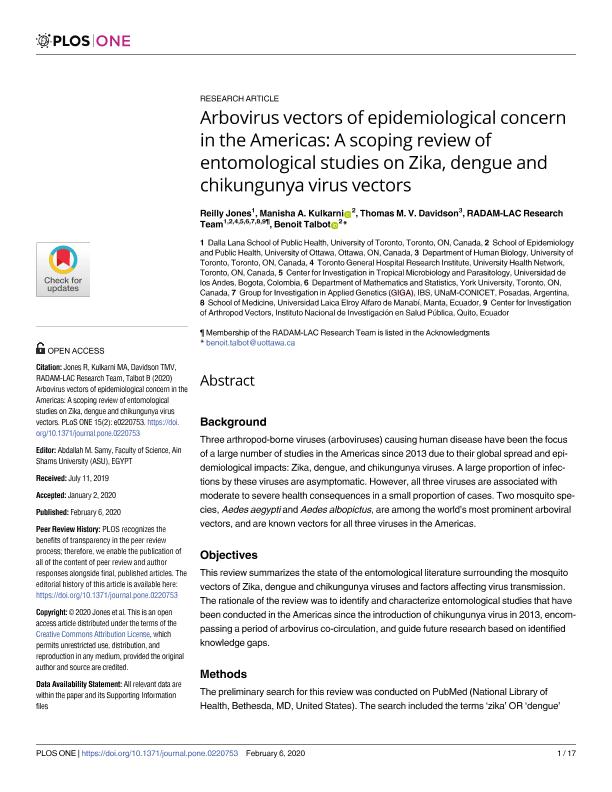Mostrar el registro sencillo del ítem
dc.contributor.author
Jones, Reilly
dc.contributor.author
Kulkarni, Manisha A.
dc.contributor.author
Davidson, Thomas M.V.
dc.contributor.author
Sander, Beate
dc.contributor.author
González, Camila
dc.contributor.author
Wu, Jianhong
dc.contributor.author
Miretti, Marcos Mateo

dc.contributor.author
Espinel, Mauricio
dc.contributor.author
Cevallos Viteri, Varsovia Enid

dc.contributor.author
Cevallos, Varsovia
dc.contributor.author
Talbot, Benoit
dc.date.available
2022-03-03T11:28:11Z
dc.date.issued
2020-02
dc.identifier.citation
Jones, Reilly; Kulkarni, Manisha A.; Davidson, Thomas M.V.; Sander, Beate; González, Camila; et al.; Arbovirus vectors of epidemiological concern in the Americas: A scoping review of entomological studies on Zika, dengue and chikungunya virus vectors; Public Library of Science; Plos One; 15; 2; 2-2020; 1-17
dc.identifier.issn
1932-6203
dc.identifier.uri
http://hdl.handle.net/11336/152816
dc.description.abstract
Background Three arthropod-borne viruses (arboviruses) causing human disease have been the focus of a large number of studies in the Americas since 2013 due to their global spread and epidemiological impacts: Zika, dengue, and chikungunya viruses. A large proportion of infections by these viruses are asymptomatic. However, all three viruses are associated with moderate to severe health consequences in a small proportion of cases. Two mosquito species, Aedes aegypti and Aedes albopictus, are among the world´s most prominent arboviral vectors, and are known vectors for all three viruses in the Americas. Objectives This review summarizes the state of the entomological literature surrounding the mosquito vectors of Zika, dengue and chikungunya viruses and factors affecting virus transmission. The rationale of the review was to identify and characterize entomological studies that have been conducted in the Americas since the introduction of chikungunya virus in 2013, encompassing a period of arbovirus co-circulation, and guide future research based on identified knowledge gaps. Methods The preliminary search for this review was conducted on PubMed (National Library of Health, Bethesda, MD, United States). The search included the terms ´zika´ OR ´dengue´ OR ´chikungunya´ AND ´vector´ OR ´Aedes aegypti´ OR ´Aedes albopictus´. The search was conducted on March 1st of 2018, and included all studies since January 1st of 2013. Results A total of 96 studies were included in the scoping review after initial screening and subsequent exclusion of out-of-scope studies, secondary data publications, and studies unavailable in English language. Key findings We observed a steady increase in number of publications, from 2013 to 2018, with half of all studies published from January 2017 to March 2018. Interestingly, information on Zika virus vector species composition was abundant, but sparse on Zika virus transmission dynamics. Few studies examined natural infection rates of Zika virus, vertical transmission, or co-infection with other viruses. This is in contrast to the wealth of research available on natural infection and co-infection for dengue and chikungunya viruses, although vertical transmission research was sparse for all three viruses.
dc.format
application/pdf
dc.language.iso
eng
dc.publisher
Public Library of Science

dc.rights
info:eu-repo/semantics/openAccess
dc.rights.uri
https://creativecommons.org/licenses/by/2.5/ar/
dc.subject
ARBOVIRUS
dc.subject
ARBOVIRAL VECTORS
dc.subject
EPIDEMIOLOGY
dc.subject
REVIEW
dc.subject.classification
Medicina Tropical

dc.subject.classification
Ciencias de la Salud

dc.subject.classification
CIENCIAS MÉDICAS Y DE LA SALUD

dc.title
Arbovirus vectors of epidemiological concern in the Americas: A scoping review of entomological studies on Zika, dengue and chikungunya virus vectors
dc.type
info:eu-repo/semantics/article
dc.type
info:ar-repo/semantics/artículo
dc.type
info:eu-repo/semantics/publishedVersion
dc.date.updated
2021-11-08T17:52:25Z
dc.journal.volume
15
dc.journal.number
2
dc.journal.pagination
1-17
dc.journal.pais
Estados Unidos

dc.journal.ciudad
San Francisco
dc.description.fil
Fil: Jones, Reilly. University of Toronto; Canadá
dc.description.fil
Fil: Kulkarni, Manisha A.. University of Ottawa; Canadá
dc.description.fil
Fil: Davidson, Thomas M.V.. University of Toronto; Canadá
dc.description.fil
Fil: Sander, Beate. Public Health Ontario; Canadá
dc.description.fil
Fil: González, Camila. Universidad de Los Andes; Venezuela
dc.description.fil
Fil: Wu, Jianhong. York University ; Canadá
dc.description.fil
Fil: Miretti, Marcos Mateo. Consejo Nacional de Investigaciones Científicas y Técnicas. Centro Científico Tecnológico Conicet - Nordeste. Instituto de Biología Subtropical. Instituto de Biología Subtropical - Nodo Posadas | Universidad Nacional de Misiones. Instituto de Biología Subtropical. Instituto de Biología Subtropical - Nodo Posadas; Argentina
dc.description.fil
Fil: Espinel, Mauricio. Universidad Laica Elroy Alfaro de Manabí; Ecuador
dc.description.fil
Fil: Cevallos Viteri, Varsovia Enid. Instituto Nacional de Salud Pública; Ecuador
dc.description.fil
Fil: Cevallos, Varsovia. Instituto Nacional de Salud Pública; Ecuador
dc.description.fil
Fil: Talbot, Benoit. University of Ottawa; Canadá
dc.journal.title
Plos One

dc.relation.alternativeid
info:eu-repo/semantics/altIdentifier/doi/http://dx.doi.org/10.1371/journal.pone.0220753
dc.relation.alternativeid
info:eu-repo/semantics/altIdentifier/url/https://pubmed.ncbi.nlm.nih.gov/32027652/
Archivos asociados
